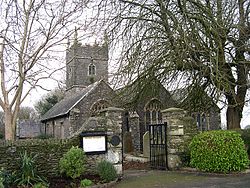St Budeaux
| St Budeaux | |
| Devon | |
|---|---|
 The Parish Church of St Budeaux | |
| Location | |
| Grid reference: | SX4458 |
| Location: | 50°24’12"N, 4°11’8"W |
| Data | |
| Population: | 13,369 (2011) |
| Post town: | Plymouth |
| Postcode: | PL5 |
| Dialling code: | 01752 |
| Local Government | |
| Council: | Plymouth |
| Parliamentary constituency: |
Plymouth Devonport |
St Budeaux is an ancient parish to the north-west of Plymouth in Devon. The name St Budeaux comes from Saint Budoc, the Bishop of Dol (Brittany). Around AD 480, Budoc is said to have founded a settlement and built a small church. The church eventually gave way to a permanent stone one, dedicated to Saint Budoc, which was erected shortly before the Norman conquest.
The village is documented in the Domesday Book of 1086. Known as Bucheside, it was valued at 30 shillings (around six times the amount of neighbouring manors). Over the course of the next few hundred years, Bucheside became Bodekishide, Budeokshed, and even Bottockishide. The modern name, St Budeaux, is itself a Frenchified "elegant" form.
Contents
1400s to 1700s
St Budeaux became a separate parish in 1482 by the decision of the Bishop of Exeter. During the early Tudor period, demand grew for a larger church, which was completed in 1563. The church was described in 1804 as "a simple edifice, and, though devoid of architectural embellishment, possesses much picturesque beauty." On 4 July 1569, Sir Francis Drake married local woman Mary Newman (Lady Drake was buried there in 1582).
During the Civil War, Plymouth and its surrounding villages (including St Budeaux) swore an oath to die for the Parliamentarian cause. They were besieged by the Royalist Cornwall just across the water, which took control of St Budeaux and used the church as a garrison. The church was virtually destroyed by the war's end and was not restored until 1655.
1800s
In 1860, the War Department purchased a sizable amount of land in the area due to Prime Minister Lord Palmerston's fear of the French, then ruled by Napoleon III. His fear was exaggerated, and the line of military forts encircling Plymouth later became known as "Palmerston's Follies." However, the upheaval contributed to an increase in the local population and a subsequent change in the area's character. Agaton Fort (see below) was only 480 yards to the north of St Budeaux and was completed in 1871.
In the 1890s, the parish became a self-contained village with significant development in Lower St Budeaux. Much of the development was incited by General John Trelawney, formerly John Jago, who inherited a great deal of St Budeaux's land from his uncle in 1883. In 1890, the village was already growing due to the construction of the Royal Albert Bridge and the improvement of area roads, as well as a new London and South Western Railway station, St Budeaux Victoria Road. There was also a Great Western Railway station at St Budeaux Ferry Road. In the following decade, Trelawney built houses and roads and sold to Joseph Stribling the land that would become the Trelawny Hotel in 1895. The hotel included two bars, a bar parlour, a club room, a coach house, outbuildings, stables and yards, and was the first building in St Budeaux to be lit by electricity. Many new shops also opened in the area during the same time period.
In 1899, St Budeaux merged with the town of Devonport, resulting in many improvements to local roads and communications availability. Improvements included the construction of a new railway bridge enabling the Devonport and District Tramway Company to provide efficient service from Devonport, through St Budeaux, to Saltash Passage, linking Plymouth to Cornwall.
1900s
In 1914, following World War I, St Budeaux and the other towns and villages in the area were amalgamated into the city of Plymouth. Amid the heavy demolition and construction of this period, six more churches were built in the parish. Much of this activity was initiated by the Plymouth Corporation, which made a habit of buying up the estates of principal landowners and destroying them in order to develop new amenities on the land. The vicar of St Budeaux church at the time, the Reverend T. A. Hancock, was appalled by the Corporation's actions and protested in the 1930s, but to no avail.
Many homes in the region were bombed during the World War II, and subsequent rebuilding resulted in a housing explosion.
Modern St Budeaux
Today, St Budeaux includes a Catholic church, a Methodist church, a Baptist church and two Church of England churches. It also has a public library, three pubs, four primary schools and two railway stations, although the village does not have its own secondary school. Most of the main shops are situated in St Budeaux Square which is adjacent to Wolseley Road. Most children of secondary school age in the area attend Marine Academy Plymouth in nearby King's Tamerton or bus to one of the residual grammar schools or one of the many other community colleges.
Agaton Fort
Part of the north-eastern defences of Plymouth, work on Agaton Fort started in 1863 on a hill near the hamlet of Agaton, in the parish of St Budeaux. It is a five-sided polygonal fort, and was designed to mount fifteen 7-inch guns which could mutually support the neighbouring Ernesettle Fort and Knowle Battery. The initial contractor failed in 1866 and the work was completed in 1871 by Royal Engineers. Only three of the 7-inch guns were ever mounted, along with five 64-pounder guns for close defence. It was also protected by a dry ditch and three caponiers. The fort was disarmed in the 1890s, but continued in military use through both World Wars.[1] It is now a VOSA Test Station and is a Scheduled monument.[2]


